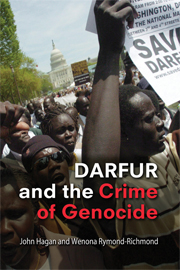Book contents
- Frontmatter
- Contents
- Glossary
- List of Characters
- Prologue: On Our Watch
- Darfur and the Crime of Genocide
- Settlement Cluster Map of Darfur, Sudan
- 1 Darfur Crime Scenes
- 2 The Crime of Crimes
- 3 While Criminology Slept with Heather Schoenfeld
- 4 Flip-Flopping on Darfur with Alberto Palloni and Patricia Parker
- 5 Eyewitnessing Genocide
- 6 The Rolling Genocide
- 7 The Racial Spark
- 8 Global Shadows
- Epilogue: Collective R2P
- Appendix: Genocidal Statistics
- Notes
- Index
- Titles in the series
8 - Global Shadows
Published online by Cambridge University Press: 05 June 2012
- Frontmatter
- Contents
- Glossary
- List of Characters
- Prologue: On Our Watch
- Darfur and the Crime of Genocide
- Settlement Cluster Map of Darfur, Sudan
- 1 Darfur Crime Scenes
- 2 The Crime of Crimes
- 3 While Criminology Slept with Heather Schoenfeld
- 4 Flip-Flopping on Darfur with Alberto Palloni and Patricia Parker
- 5 Eyewitnessing Genocide
- 6 The Rolling Genocide
- 7 The Racial Spark
- 8 Global Shadows
- Epilogue: Collective R2P
- Appendix: Genocidal Statistics
- Notes
- Index
- Titles in the series
Summary
The Global North and South
Should it be entirely surprising that the United States, a country with a history of importing African slaves and massively killing and displacing its indigenous people, would centuries later respond in ambivalent ways to Sudan, an African country that enslaved, killed, and displaced its own indigenous population? Perhaps these countries are not as entirely different as they at first seem. There may be lessons of broader relevance in the disconnected but in some ways similar and overlapping experiences of the United States and Sudan. Criminology can be one important source of these lessons.
We start with two jarringly different images of the consequences of Sudan's recent genocidal history. The first image involves the well-told story in Megan Mylan and Jon Shenk's documentary, the Lost Boys of Sudan, and in Dave Eggers's novel, What Is the What. These tell the true tale of the thousands of young boys who, when confronted with terrifying choices in the early 1990s between being child soldiers, becoming slaves, or being killed, chose to flee from southern Sudan to refugee camps in Ethiopia. When life proved desperate there too, many of these youth fled back through the still raging killing fields of southern Sudan, winding up in refugee camps in Kenya. Finally, in 2000, the U.S. government brought some of these youth to the United States, where they received help, often from church groups, in negotiating a challenging reintegration into more normal lives in the Global North.
- Type
- Chapter
- Information
- Darfur and the Crime of Genocide , pp. 193 - 218Publisher: Cambridge University PressPrint publication year: 2008

